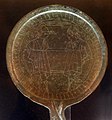Museo Etrusco Guarnacci
The Museo Etrusco Guarnacci is one of the oldest public museums in Europe and is located in the Palazzo Desideri Tangassi in Volterra , Tuscany .
history
The museum was founded in 1761 after the noble abbot Mario Guarnacci (1707–1785) bequeathed his collection of archaeological artifacts to the public of Volterra. The donation also included a library of over 50,000 volumes. Mario Guarnacci was a historian and wrote, among other things, Le Origini Italiche (1767), a story about ancient Italy. His collection attracted the attention of scholars such as Giovanni Lami , Scipione Maffei and Antonio Francesco Gori , who dealt with the scientific dissemination of the finds from his collection through important publications and regular news in magazines such as Le Novelle Letterarie published in Florence by Lami .
The museum was originally located in the Palazzo Maffei on Via Guidi, now Via Matteotti, which Guarnacci bought to display his property. After his death in 1785, the pieces were moved together with the library to the Palazzo dei Priori from the 13th century. The collection stayed here until 1877. After it had grown steadily over time through donations, purchases and finds, it was housed by Niccolò Maffei (1833–1887), the director at the time, in the Palazzo Desideri Tangassi, where it is also located still located today. The Biblioteca Guarnacciana has been located in the Palazzo Vigilanti three houses away from the Museo Guarnacci since 1985 with the city archives and the city library.
exhibition
In 1877 Niccolò Maffei had divided and arranged the exhibits into individual classes. Recently, this historical arrangement has been supplemented with a chronological exhibition of Etruscan art.
Historical exhibition
ground floor
- Room IV: urns with ornamental motifs such as demons and rosettes
- Room V: urns with fantasy figures and wild animals
- Room VI: Urns with the greeting of the deceased to the bereaved family
- Room VII: Urns with the journey to the underworld on horseback
- Room VIII: urns with covered wagons ( carpentum )
- Room IX: urns with four horses
1st floor
- Rooms XIII to XIX: urns with depictions from Greek mythology, including Oedipus and the Sphinx, Seven against Thebes, the robbery of Helena and Theseus with the Minotaur
- Room XX: The bronze statue Ombra della sera and the urn of the bride and groom from the late Etruscan period
- Rooms XXI to XXIII: urns with representations from Greek mythology, including Odysseus and the Sirens and the Blinding of Polyphemus
- Room XXIV: Coin cabinet with Etruscan coins made of gold, silver, bronze and over 3000 coins from Greece, the Roman Republic and the Imperial Era
- Room XXV: Goldsmith's art and gems
- Room XXVI: objects from the urban environment and a reconstruction of the dedication inscription from the Roman theater in Vallebona
All rooms on the first floor of the museum are covered with mosaics from buildings from the Roman Empire.
Chronological exhibition
ground floor
- Room I and la: prehistoric and early historical finds, reconstructions of graves from the early Iron Age and objects from the necropolises of Badia, Guerruccia and Ripaie
- Room II: Objects from the orientalizing and archaic epochs (7th and 6th centuries BC), including a Bucchero kyathos, several bronze figures and the stele of Avile Tite
- Room III: Artifacts from the Classical period (5th century BC), including a carnelian scarab, an Attic crater and some bronze figures from the early Classical period
2nd floor
handicrafts and funerary art from the Hellenistic period (4th to 1st century BC)
- Rooms XXVII and XXVIII: grave fittings with urns from the 3rd and 2nd centuries BC Chr.
- Room XXIX: Reconstruction of an ancient workshop with tools
- Room XXX: grave fittings with urns made of alabaster
- Room XXXI: bas-reliefs with Greek myths or scenes from the journey of the dead in the afterlife
- Rooms XXXII and XXIIa: urn lid with portraits of the deceased
- Rooms XXXIII and XXXIV: bronze work including mirrors, votive figures, tableware and coins
- Room XXXV: Tombs, including the marble statue of a woman with child ( Kourotrophos Maffei )
- Rooms XXXVI and XXXVII: red-figure ceramic vases
Web links
- Museo Etrusco Guarnacci - Volterra. Musei Val di Cecina, accessed January 3, 2020 .
- Museo etrusco Guarnacci. Comune di Volterra, accessed January 4, 2020 (Italian).
- Biblioteca Guarnacci, Archivio storico e Biblioteca Comunale. Comune di Volterra, accessed January 5, 2020 (Italian).
- Publications on the museum on the Internet Culturale
Coordinates: 43 ° 24 ′ 3.2 ″ N , 10 ° 51 ′ 51.5 ″ E






